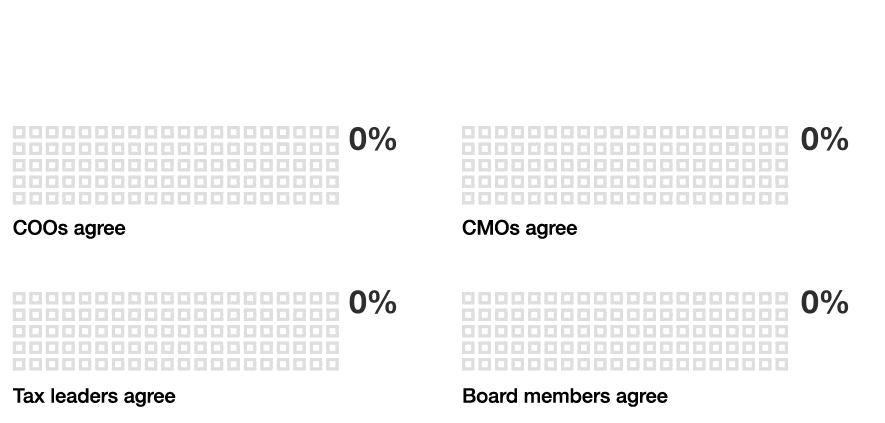
PwC Pulse Survey: Focused on reinvention 2023
Read time: 13 minutes
Executive summary
US companies are shifting from defense to offense. In our latest Pulse Survey, business executives say they’re less focused on reacting to external disruptions and instead looking inward, to transform and reinvent. After three years of complex challenges — including the pandemic, supply chain disruptions, a shift to hybrid work, rising interest rates and increased economic uncertainty — the business environment is finally starting to stabilize. Recessionary fears are easing, consumer spending has held up and confidence is rising.
Executives now have the opportunity to transform their companies — and capitalize on economic expansion when it starts to ratchet up again. The biggest transformation priorities? Embedding technology and investing in the workforce.
Key findings include:
- Recessionary concerns are easing. Just 17% of business executives strongly agree that there will be a recession in the next six months, a drop from 35% in October 2022.
- Business risks are less pronounced. Executives still point to the same risks as in 2022 (and rank them in roughly the same order): more frequent and severe cyber attacks, an uncertain economy and talent acquisition. But a smaller share of executives cite these as direct threats to their business.
- Executives are far more likely to invest in future growth rather than hunker down. More than a quarter (27%) want to embed new technologies into their business model, and 24% are focused on new revenue streams — more than any other strategic priority.
- Tech implementation remains a key challenge to transforming. Companies are willing to make the upfront investment, but they struggle to capture value from new tech once it’s in place. The vast majority (88%) say achieving measurable value from new technology is a challenge, followed by updating their operating model to support their new vision (85%), covering the cost of new technology (85%) and training the workforce (84%) on new tech.
- Executives are largely happy with their current workforce strategy. Nearly three-fourths (74%) say they can attract and retain the talent they need. Similarly, 74% say they have the right culture in place for reinvention.
- Half of executives cite climate change as a risk to their business. Only 19% see it as a serious threat, down from 23% in 2022. Companies are more likely to comply with sustainability reporting disclosures and SEC requirements, but only 23% are planning for climate-related disruptions.



A more manageable risk environment
17%
of business executives anticipate a recession in the next six months
Overall, executives see fewer risks as direct threats to their business compared to 2022. For example, only 23% of C-level executives cite a recession as a serious risk. Meanwhile, only 17% of business executives strongly anticipate a recession in the next six months, a drop from 35% in October 2022. The sentiment varies across the C-suite — just 8% of chief financial officers (CFOs) anticipate a recession, compared to 27% of chief operating officers (COOs).


Source: PwC Pulse Survey, August 22, 2023: base of 609; PwC Pulse Survey, November 2, 2022: base of 657
The risk landscape seems to be easing on several other fronts, as well. After wading through the Great Resignation and ensuing talent shortage, only 26% of executives now say finding and keeping talent is a serious risk. Executives also say the US regulatory environment and climate change present less risk to their business now than they did this time last year.
Many risks remain, however. Cyber attacks present the biggest current potential risk, with 74% of executives saying this is either a moderate or serious risk. In addition, while the odds of a recession may be lower, economic growth is still likely to be uneven — at best. Nearly three-quarters (72%) point to an uncertain macroeconomic environment as a moderate or serious risk. A related risk is margin pressure (68% see it as a moderate or serious risk). Inflation is declining but remains above policymaker targets, and many companies may not have sufficient pricing power to sustain margins.
As companies seek to transform, executives should understand how that process can compound or mitigate potential risks. Executed correctly — with the right forethought and planning — a transformation can leave companies more resilient and better equipped to anticipate and mitigate risks. Implemented incorrectly, however, a large change program can leave companies worse off than before. In fact, a transformation can itself introduce new sources of uncertainty and risk. The key to success? Execution.
What your company can do
It’s not just about risk. Make trust by design a central component in all transformation and reinvention plans — at the beginning and throughout. Look ahead to anticipate how a transformation will impact your company’s governance, risk and controls. Over-index on execution and implementation to avoid introducing new operational and financial risks directly due to the transformation.
Factor cybersecurity into transformation plans at the beginning — especially those that entail digitizing processes or cloud computing. These can create new vulnerabilities that hackers can exploit. Also look at new technology as a means to help boost your cybersecurity and other controls.
Strengthen scenario-planning and war-gaming processes to anticipate emerging risks. The biggest threats to your company are the risks you don’t see coming.





Transforming through technology
#1
Embedding new technologies into their business model is the top strategic priority among business executives over the next three to five years.
In thinking about technology investments, some executives may lose sight of the ultimate business outcome objective and end up tempted by the latest bright, shiny objects. More executives plan to embed new technologies into their business model than any other strategic priority over the next three to five years. To get there, 59% say they will invest in new technologies such as cloud or artificial intelligence (AI) in the next 12 to 18 months. Nearly half (46%) say they’ll invest in generative AI (GenAI) specifically.


The challenge is that in a rapidly changing tech environment, many companies are still waiting for the payoff from their last round of tech investments. When asked about challenges to transformation, a staggering 88% of executives point to achieving measurable value from new tech, more than any other issue. Similarly 85% point to the cost of adoption for new technologies, and 84% cite training talent on new tech.
Employee fears about being replaced by technology are a factor as well. Three-fourths of the executives cite this as a challenge to transforming their business. Transformations have a much better chance of success when the workforce buys in, is fully engaged in and helps shape the process. Companies need to make the investment in their people by giving them the tools they need to do their jobs more easily and by training them on new technologies.


Executives don’t appear to think these issues are unique to their individual companies. When asked if their company is behind the competition in adopting new technologies, 48% either somewhat or strongly agree. We see some variation across C-suite roles. COOs are less optimistic, with 68% agreeing they are behind, whereas tax leaders are more optimistic, with only 33% saying the same.
Leadership teams should be more selective, and skeptical, about major tech initiatives. Before launching a new initiative, they should have a very clear idea of how a technology will create value — for example, streamlining processes, creating efficiencies, enhancing the customer experience or boosting sales.


Source: PwC Pulse Survey, August 22, 2023: base of 609, COO base of 77, CMO base of 87, Tax leader base of 97, Board of Director base of 55
What your company can do
Keep business outcomes top of mind in order to drive tangible results on shorter timelines. Your ability to lower costs or improve margins can be the springboard for reinvesting any gains to reinvent your business.
Prioritize data. You need effective access to high-quality data to build new products and new services and to take advantage of new technologies and AI.
Have a clear business plan for any large-scale program, with a quantifiable ROI, an explicit sense of how the program can create new value and intermediate milestones to give an early indication of whether the program is on track.
Engage your employees in the change program, particularly regarding how technology can affect behaviors and ways of working. Solicit input early on, explain what will change, communicate transparently about end-state objectives and conduct quick-hit surveys to gauge whether they’ve bought into the program.
Train your employees on the technology they’ll be using and give them time to learn. This can help ease concerns.



Prioritizing people
74%
of executives say they attract and retain the people they need
Recognizing the significant costs of hiring and retraining, along with the damage to morale from layoffs, executives are strategically investing to develop and retain talent. Moreover, they feel good about their current talent pools. Nearly three-fourths (74%) agree or strongly agree that they successfully attract and retain the talent they need.
When asked about their workforce policies, executives are focusing on their current employees. Companies are also investing in upskilling initiatives to train employees on new technology (cited by 64% of executives) and expanding the benefits they offer. Nearly two-thirds (64%) say they’ve expanded or plan to expand mental health benefits, a slight increase over 2022 and a likely acknowledgment that many segments of the US workforce are tired and stressed. Similarly, 60% either plan to or have already increased compensation for their existing employees.


Our current survey finds that 52% of executives either have a plan in place or have already implemented headcount reductions (27% have a plan in place but haven't started, 26% have implemented). This is largely unchanged from our August 2022 Pulse Survey, when 50% said the same (28% had a plan in place but hadn't started, 23% had already implemented.)
Looking forward, 74% of business executives agree or strongly agree that they have the right culture for reinvention — but that may be optimistic. In PwC’s recent Hopes and Fears survey, employees were far less likely to say their company had the right culture in place to support reinvention. For example, only 35% of employees said that their manager tolerates small-scale failures, and just 33% said their manager encourages dissent and debate. Those are foundational elements of culture, and they’re a prerequisite for reinvention, which requires that executives, managers and employees all feel that they can experiment, make mistakes and speak up. In launching major transformation initiatives, companies need to make sure that their current culture is reinvention-ready.


What your company can do
Move away from traditional job descriptions and organizational structures and focus on skills instead. A skills-based approach to human capital has implications across the organization, from designing career paths to building project teams to bonuses, incentives and performance management.
Make sure that your understanding of the company culture is grounded in objective data rather than perceptions in the C-suite. Our 2023 Trust Survey shows several examples of gaps between executive and employee views. Conduct surveys to gauge employee sentiment and track progress to make sure that you address issues.
Communicate your employee value proposition far and wide. If your benefits are better than the competition’s, that gives you a big advantage in recruiting and retention — but only if potential recruits and applicants know about it.
One area of work to be done is succession planning. Nearly 80% of business executives cite poor succession planning as a challenge to their company’s ability to transform in the next three to five years.



A potential blind spot on climate
19%
of executives see climate change as a serious risk to their company, down from 23% in 2022
The headlines in 2023 have been dominated by extreme weather events, but climate change remains relatively low on the list of business risks among respondents. Half of business executives in our survey cite it as a risk to their business. Only 19% cite it as a serious risk, down from 23% in 2022.
Companies are preparing for compliance, however. More than two-thirds of the executives (69%) say they’re prepared to comply with coming sustainability reporting requirements, and 66% are actively engaging with or closely monitoring SEC regulatory activity and proposed disclosure rules. Climate change is an extremely complex issue, but compliance is straightforward. It’s much easier for companies to adhere to externally generated guidance and requirements than it is to rethink business models and take other forward-looking steps to decarbonize.
Only 23% of executives in our survey are contingency planning for climate-related disruptions in the next 12 to 18 months. Some may already have taken steps related to climate and don’t plan to allocate more in the near term, while others may be playing catch-up. Given the 18 separate weather and climate disasters in 2022, each of which cost $1 billion in damage, it’s important for management to discuss the issue with their board and factor it into their strategy and risk management in order not to fall behind. It also presents an opportunity for companies to invest in greater resilience measures.
Among specific roles in the C-suite, CHROs are the most likely to recognize the issue, and 62% of CHROs cite climate change as a severe or moderate risk, compared with just 37% of CFOs (and 50% of all respondents). And more than a third of CHROs (35%) say they’re preparing contingency plans for climate-related disruptions in the next 12 to 18 months. There are two possible explanations for why CHROs are more focused on climate.
A growing awareness of environmental issues among both the current workforce and potential recruits. Companies that lead in this area can use it at a point of differentiation in attracting and retaining talent.
CHROs need to think about how to keep their workforce safe in the event of extreme weather events — something that’s happening with greater frequency as the planet continues to warm.
What your company can do
Treat environmental sustainability less as a disruption you need to mitigate and more as a potential opportunity. The energy transition entails a massive shift in the way power is generated, stored and consumed, which can trigger a wave of new business and revenue for companies that look ahead, rather than clinging to the status quo.
Expect the unexpected. Weather-related disruptions are increasing in both severity and frequency. Even if your company and workforce aren’t directly affected, there’s a good chance that some of your suppliers and/or customers could be. Run worst-case-scenario modeling across the entire value chain, from raw materials to end users, and plan for disruptions.
Build climate-change implications into your transformation plan. As with cyber, a large-scale reinvention can potentially create new climate vulnerabilities — for example, if you shift operations to a location where rising sea levels are a more immediate threat.


Source: PwC Pulse Survey, August 22, 2023: base of 609



Policy priorities remain consistent
82%
of business executives are monitoring or engaging policymakers on cybersecurity
The top policy areas on the leadership agenda remain consistent from a year ago. Among business executives, 82% are closely monitoring or actively engaging with policymakers about cybersecurity, and 68% say the same about privacy. Notably, however, these numbers are lower than in 2022. Executives are focused on the same policy areas, but fewer are tracking them as closely.


One area of change is the rapid rise of generative AI, where 46% say they plan to invest over the next 12 to 18 months. Two-thirds (67%) agree or strongly agree that they will use it to support business models over the same time period, with chief information officers and chief marketing officers leading the way. Generative AI has policy implications as well, with 61% closely monitoring policy developments or actively engaging policymakers regarding regulatory and legislative action about generative AI.


Given Pillar Two’s potential implications on business, it’s little surprise that 68% of executives are engaging with policymakers or monitoring global and US tax policy. Just over half (52%) say they’re tracking Supreme Court decisions, and one in five executives say they’re already assessing the business impact of the recent Supreme Court decision on affirmative action, with 28% planning to do so.
What your company can do
- Focus on cybersecurity and privacy at the front end of transformations — especially those that use digital technology to improve the customer experience or streamline workflows. All too often, companies think of cybersecurity and risk after the fact, when changes can be harder to implement.
- Create the right data governance model. Data is the principal asset at many organizations, and it needs to be treated as such — particularly given rising concerns about data privacy in some markets. Project teams need access to customer data to develop new products and services, but safeguards need to be in place to prevent incidental disclosures or new vulnerabilities.
- Continue to monitor any policy shifts and understand how they might impact your business, particularly as the US presidential election gets under way.

- Consumer markets
- Energy and utilities
- Financial services
- Health industries
- Industrial products
- Tech, media, telecom
- Private companies
Consumer markets
Focused on reinvention: What’s top of mind in the C-suite?
About the survey
Between August 1 and August 8, 2023, PwC surveyed 609 US executives, including CFOs and finance leaders (22%), tax leaders (15%), risk management leaders, including CROs, CAEs and CISOs (13%), CIOs, CTOs and technology leaders (13%), CHROs and human capital leaders (13%), COOs and operations leaders (10%), corporate board directors (8%) and CMOs and marketing leaders (6%). Respondents were from public and private companies in six sectors: industrial products (27%), consumer markets (22%), financial services (19%), technology, media and telecom (18%), health industries (7%) and energy and utilities (6%). The Pulse Survey is conducted on a periodic basis to track the changing sentiment and priorities of business executives.

















